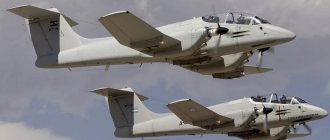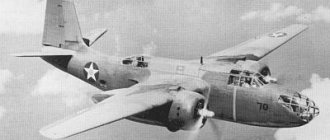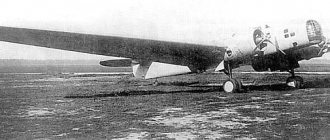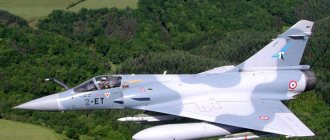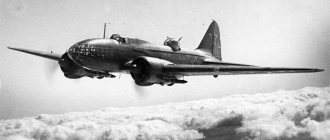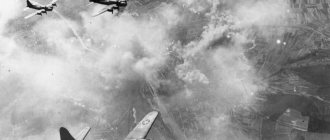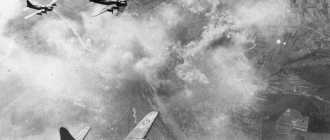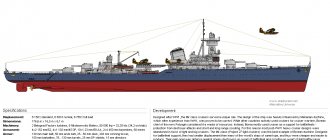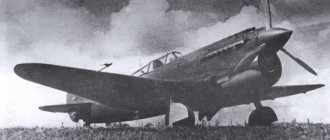Carrier-based fighter-bombers F/A-18 Hornet, Super Hornet (USA)
The F/A-18 Hornet carrier-based fighter-bomber is today one of the most successful modern combat aircraft and the main combat aircraft of the US Navy.
The history of its creation begins in the sixties of the last century, when the P.530 Cobra aircraft was designed. Subsequently, having been redesigned, it received the designation YF-17 and in 1976 took part in the US Air Force competition to create a light multi-role fighter. In it, he defeated the project of a similar aircraft, the YF-16. However, Northrop did not have the necessary experience to develop a carrier-based aircraft version. Therefore, further work on the project was carried out in collaboration with (since 1997 - Boeing), which had such experience. McDonnell Douglas began developing the carrier-based F/A-18 fighter, while Northrop was developing the ground-based F-18L. The F/A-18 carrier-based fighter was named Hornet.
In the end, the cooperation between the two enterprises turned into a lawsuit. Northrop accused McDonnell-Douglas of illegally using its developments. Douglas managed to stop the case by paying off fifty million dollars. From that time on, Hornet became entirely his project. But the F-18L variant was never put into mass production.
When designing the Hornet aircraft, much attention was paid to such parameters as survivability and reliability. Survival is ensured by a set of measures: low visibility of the aircraft, its combat survivability, and the presence of weapons that operate beyond the reach of enemy air defense systems.
The aircraft has small dimensions, smoke-free engines, and weak infrared radiation. All this, combined with the presence of electronic warfare equipment on board, makes its detection difficult.
The power plant includes two General Electric engines built specifically for this aircraft. The engines are separated by a special fireproof titanium partition. The thrust of one engine is enough for the plane to return to base. The power plant compartment is equipped with fire detection and extinguishing systems.
The fuel system consists of six tanks. To avoid an explosion in the event of combat damage, all fuel tanks are filled with foam plastic.
The main material from which the aircraft is made are aluminum alloys (almost 50%). The rest is made up of titanium alloys, high-strength steels, and composite materials. The aircraft's airframe is designed for 6,000 hours of operation, or 2,000 takeoffs and landings.
The aircraft's powerful computer complex includes more than 20 computers. The main ones are two AN/AYK-14 computers. And the modern multi-mode radar APG-65 has become a landmark among fighter radars.
The F/A-18 aircraft allows for much more precise use of existing weapons than its predecessors. This is a truly multi-role fighter-bomber capable of air combat.
Hornet fighters are in service with 24 squadrons of the US Navy. They are based on aircraft carriers. Typically, a carrier air wing includes 3 squadrons of these aircraft.
FIGHTER-BOMBER BOEING F/ A-18 A / C "HORNET"
The first of 11 experimental Hornet aircraft took flight on November 18, 1978. An initial batch of 371 single-seat F/A-18A variants was ordered. In 1982, their deliveries to the fleet began.
On January 7, 1983, the first combat-ready squadron armed with F/A-18A aircraft was commissioned - the 314th Fighter Bomber Squadron of the US Marine Corps "Black Knights".
The aircraft first saw combat use during Operation Eldorado Canyon in Libya, carried out in April 1986. They also participated in Operations: Desert Storm (1991), Desert Fox (1998), and Enduring Freedom (2001). ), "Freedom for Iraq" (2003-2010).
The F/A-18A modification was replaced by the F/A-18C variant, which was produced until 1999. The US Armed Forces purchased 347 of these vehicles. The first F/A-18C aircraft flew on September 3, 1986. This aircraft can carry AIM-120 AMRAAM air-to-air missiles and AGM-65 Maverick air-to-surface missiles with a thermal seeker. It also features more modern avionics, and the flight deck is equipped with a NACES ejection seat.
After the construction of the first 137 F/A-18C fighters, the production of modifications for operations in night conditions began. The pilots of these aircraft are equipped with Cats Eye night vision goggles, and their equipment includes AAR-50 containers with a tactical inertial navigation system and AAS-38 with a heat direction finder, Kaiser AVQ-28 ILS and color multifunction displays. The first Hornet night fighter entered service on November 1, 1989.
The versatility of this model has contributed to its success in the foreign market. Its first foreign buyer was Canada (98 single-seat CF-188A aircraft), then Australia purchased 57 aircraft in the AF-18A variant. The Spanish Air Force first purchased 60 EF-18A fighters (Spanish designation C.15), and at the end of 1995, another 24 F/A-18A aircraft from the US Navy reserves. The fighters were delivered to Kuwait (32 in the KAF-18C version), Switzerland (26 units) and Finland (57 units).
Hornet fighters gradually replaced such obsolete aircraft models as F-4 and F-14 fighters, A-4 and A-7 attack aircraft. After the F-14 fighters were retired in 2006, the Hornet remained the only carrier-based attack aircraft in the US Navy.
Characteristics of the Boeing F/ A-18 C Hornet :
Country of origin: USA.
Type: deck-based and land-based tactical fighter-bomber.
Armament: one built-in 20-mm six-barreled M61A1 “Vulcan” cannon; bomb load up to 7030 kg, which may include air-to-air missiles AIM-7M Sparrow, AIM-9 Sidewinder, AIM-120 AMRAAM; AGM-65 Maevrick air-to-surface missile; anti-radar missiles AGM-88 HARM; tactical missile systems AGM-84ESLAM and AGM-154 JSOW; KAB AGM-62 "Wallay", GBU-10, GBU-12 nGBU-16; PKRAEM-84 “Harpoon”; Mk.80 bombs; CBU-59 cluster bombs; nuclear bombs B57 or B61. Number of suspension points – 9.
Engines: two General Electric F404-GE-402 turbofan engines with 8035 thrust in afterburner mode.
Performance characteristics: maximum speed 1915 km/h; combat radius as a fighter is 740 km; as an attack aircraft - 1065 km. Ceiling – 15240 m.
Weights: empty 10810 kg; maximum take-off as a fighter 15235 kg; as a shock - 21890 kg.
Dimensions: wingspan (excluding missile launchers at the wing tips) 11.43 m; length 17.07 m; height 4.66 m; wing area 37.16 m.
FIGHTER BOMBER BOEING F/ A-18 B / D "HORNET"
The development of a two-seat version of the Hornet fighter began simultaneously with the creation of a single-seat version. Two TF-18A aircraft, later designated F/A-18B, were included in the initial contract. This aircraft is almost the same as the single-seat one, is equipped with the same avionics and has almost similar combat characteristics. Deliveries of the F/A-18B modification to the US Navy and Marine Corps ended at the 40th aircraft; this variant was never in service with front line combat units. F/A-18B aircraft are also in service with two reserve units, the aircraft of one of which (VFC-12) play the role of enemy fighters in exercises.
The next two-seat modification, designated F/A-18D, is very similar to the single-seat F/A-18C. It staffs the Navy's two main training squadrons (VFA-106 and VFA-125), where they train F/A-18 fighter pilots. After the construction of 31 production F/A-18D aircraft, production began of its modification, adapted for night flights, i.e., a kind of two-seat version of the F/A-18C night fighter.
A total of 109 F/A-18D night fighters were produced. These aircraft replaced the outdated Grumman A-6 Intruder all-weather subsonic attack aircraft, which were in service with the US Marine Corps. They are part of six combat and one training squadron.
A variant of the F/A-18D "Plas" was also developed that does not have duplicate controls: there is no control stick in its rear cockpit (although one can be installed if necessary), but there are two side arms control handles.
The F/A-18D aircraft of the US Marine Corps performed excellently during Operations Desert Storm (1991) and in Kosovo (1999).
Hornet two-seat fighters were exported; Now all export obligations have been fully fulfilled. The composition of the avionics is selected to suit local requirements, but in terms of their flight characteristics, the export vehicles are almost similar to those in the United States. Deliveries were made to Australia (18 ATF-18A, similar to the American F/A-18B), Canada (40 CF-18B fighters, locally designated CF-188B), Kuwait (8 KAF-18D) and Spain (12 EF-18B , received the local designation CE.15). The F/A-18D modification is also purchased by those countries that have the F/A-18C variant. These are Finland (7 aircraft) and Switzerland (8). Malaysia has acquired only eight two-seat F/A-18Ds. Thailand, which initially decided to purchase eight F/A-18C/D fighters, canceled the order.
At the request of the customer, the aircraft can be equipped with a set of APG-73 radar, improved F404-GE-402EPE engines and AMFAAM guided missiles.
The characteristics of the two-seat version of the Hornet are similar to the single-seat version.
BOEING F/ A-18 E / F “SUPER HORNET”
The result of the first significant modernization of the F/A-18C/D Hornet fighter, completed before its merger with Boeing in 1997, was the F/A-18E Super Hornet fighter-bomber. The new aircraft flew for the first time in November 1995, and on January 15, 1999, the VFA-122 squadron received its first production aircraft.
"Super Hornet" has a number of differences from its predecessor. In particular, the basis of the improved avionics was the new Raytheon APG-73 radar, which was later installed on F/A-18C fighters of later releases. The integrated REP YuESM complex consists of three main elements: the ALR-67(V)3 radar warning system, the ALQ-214 radio frequency jamming system, and the ALE-55 decoy towed using a fiber optic cable. True, the last two systems are still in the development and testing stage, so now ALE-50 towed decoys are used on aircraft.
The new modification had significantly reduced radar signature from the front and rear hemispheres. The shape of the air intakes, which are a strong source of reflection of electromagnetic radiation, has been changed. The air intake channels are curved downwards and sideways to reflect radiation away from the longitudinal axis of the aircraft. The internal surfaces of the air channels are made of radio-absorbing material. Instead of grilles covering various suction and exhaust openings, the aircraft uses perforated screens that are “transparent” to electromagnetic radiation. Considerable attention was paid to fitting a large number of body panels and filling the cavities between them, which also helped reduce the aircraft's visibility. According to the developers, the Super Hornet has implemented the most extensive measures to reduce radar signature among all modern fighters, with the exception of the F-22 and F-35.
The flight deck of the F/A-18E is similar to that of the F/A-18C, with the exception of a single large-format multi-function flat-panel liquid crystal display located on the instrument panel instead of three cathode displays. The Super Hornet aircraft has slightly increased dimensions, which made it possible to take more effective measures to reduce the radar cross section. The fuselage is lengthened by 0.86 m, the larger wing has a thicker profile and two additional external suspension units. The dimensions of the overhang along the wing tip in the root part and the area of the horizontal stabilizer and fins have been increased.
The design of the Super Hornet fighter airframe has been modified to reduce weight and reduce construction costs without sacrificing strength. The aircraft are also equipped with an advanced digital EMCS; there is no backup mechanical control system.
The F/A-18F Super Hornet is a two-seat version of the F/A-18E fighter. The rear cabin has the same equipment on the dashboard as the front one, i.e. it can be used as a place for the operator of weapons systems, and for accommodating a trainee.
The US Navy initially intended to purchase 1,000 Super Hornet aircraft, but then decided to reduce the volume of purchases. Currently, 432 units of these machines have been produced. Currently, these machines remain the basis of the aviation power of the US Navy, and this situation is unlikely to change in the foreseeable future.
Characteristics of the Boeing F/ A-18E “Super Hornet”:
Country of origin: USA
Type: single-seat carrier-based and airfield-based tactical fighter-bomber
Armament: one built-in 20-mm six-barreled M61A2 “Vulcan” cannon with 570 rounds of ammunition; bomb load up to 8050 kg, armament composition is the same as on the F/A-18C fighter. Number of suspension points – 11.
Engines: two turbofan engines General Electric F414-GE-400 with a thrust of 9990 kgf in afterburner mode.
Performance characteristics: maximum speed at high altitude 1915 km/h; combat radius as an attack aircraft when flying at high altitude with four 454 kg bombs, two AIM-9 Sidewinder air-to-air missiles and two air-dropped anti-tank tanks - 1095 km, with a 135-minute patrol over the sea with six air-to-air missiles air and three PTBs - 280 km. Ceiling – 15240 m.
Weights: empty 13865 kg; maximum take-off 29940 kg.
Dimensions: wingspan 13.62 m (including missiles installed at the ends of the wing); length 18.31 m; height 4.88 m; wing area 46.45 m.
(Based on materials from D. Donald’s reference book “Modern military aviation and air forces of the world”)
Performance characteristics of the F/A-18
F/A-18 crew
— 1 (F/A-18C) 2 (F/A-18D)
Dimensions F/A-18
— Length 17.1 m — Wing span 12.3 m — Height 4.7 m — Wing area 38 m²
Weight F/A-18
— Empty weight 10,400 kg — Curb weight 16,770 kg — Maximum takeoff weight 23,500 kg
Speed F/A-18
— Maximum speed at an altitude of 12190 meters — Mach 1.8 (1915 km/h) — Maximum ground speed — Mach 1.2 (1473 km/h) — Operational overload — 7.5 (electronically limited) — Cruising speed 1060 km/h — Climb rate 50,000 feet per minute (at the ground: 254 meters per second) - Wing load 454 kg/m² - Thrust-to-weight ratio - 1.13 (empty, at full afterburner with 50% fuel)
F/A-18 service ceiling
— 15240 m
F/A-18 ferry range
- at high altitude with three tanks - 3200 km
F/A-18 Combat Radius
— 720 km
F/A-18 weapons
— 20 mm six-barreled cannon M61A1 Vulcan, 578 rounds — can be installed on 9 hardpoints in various configurations: — V-B Guided Missiles AIM-9, AIM-7, AIM-120 of various modifications — V-Z AGM-65 Guided Missiles, AGM-88, AGM-84, AGM-154, AGM-158, KEPD-350 of various modifications - Bombs with television guidance of the GBU-10 and AGM-62 type, laser guidance of the Paveway type and GPS guidance of the JDAM type with a caliber of up to 2000 pounds - Unguided bombs such as MK and CBU calibers up to 2000 pounds (cluster, incendiary, high-explosive, volumetric explosion, concrete-piercing), BLU-107 Durandal to destroy runways. - Tactical bombs of mass destruction - nuclear (up to 340 kilotons) type B61, MK116 with a chemical charge (Sarin gases, VX), bacteriological weapons, charges with white phosphorus. — Suspended fuel tanks (up to 3 pieces), provision is made for the installation of infrared viewing containers AN/AAR-50, AN/AAS-38 “Nitehawk” and AN/ASQ-228 ATFLIR for aircraft operation at night and an AN/AWW-13 container for datalink, electronic warfare container AN/ALQ-167

